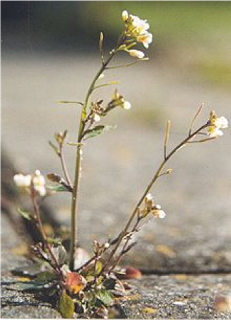
Unlike its relative A. thaliana, (above) saltwater cressthrives
in the presence of high salt levels. (Wikimedia Commons)
The Food and Agriculture Organization reported that salt levels in the soil is reducing the world’s agricultural lands at the rate of one percent a year. Concerns over feeding a growing global population with limited arable land have led to interest in developing salt-tolerant crops for food and fuel
Found on the seashores of eastern China, the model halophyte saltwater cress (Eutrema salsugineum, formerly known as Thellungiella halophila), a close relative of the plant model Arabidopsis thaliana, was selected for sequencing as part of the DOE Joint Genome Institute’s 2007 Community Sequencing Program portfolio.
The 241-million base plant genome was published by a team including DOE JGI researchers on February 24, 2013 in Frontiers in Plant Genetics and Genomics. The cress’ whole-genome sequence was compared with the published A. thaliana genome to learn more about the genes involved in salt tolerance.
For example, A. thaliana has several “Salt-Overly-Sensitive” or SOS genes. Saltwater cress has genes orthologous to these SOS genes, and the team found that if expression of the gene equivalent of SOS1 in A. thaliana was reduced, so was the cress’ salt tolerance.
“Our analyses collectively suggest that the stress-tolerance of E. salsugineum is unlikely to be determined by variation in a few genes” the researchers concluded. “A spectrum of changes in life cycle, morphology, cellular components and molecular pathways result in adaptation of E. salsugineum to environmental stresses.”